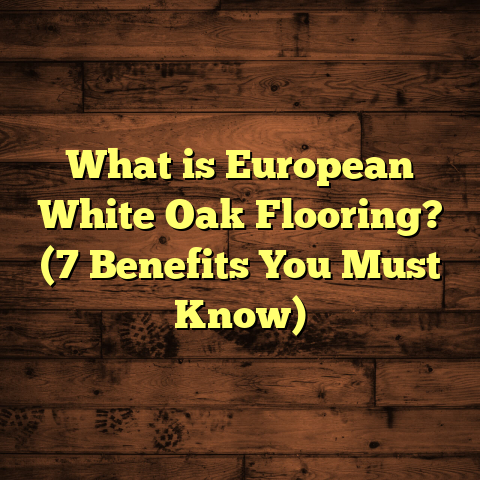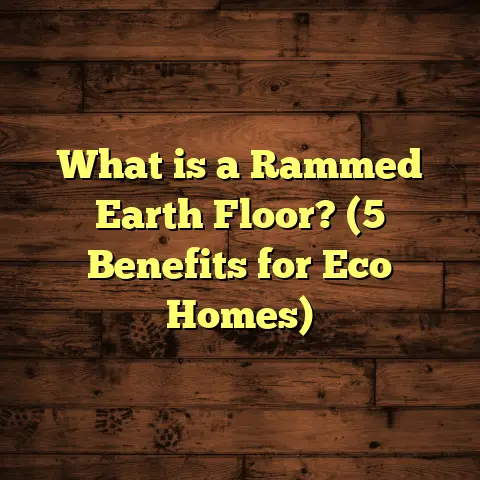What is Waterproof Laminate Flooring Made Of? (5 Key Materials)
Have you ever stopped to think about what keeps your floors safe from water damage? When I first started working with waterproof laminate flooring, I assumed the name meant the whole plank was just “waterproof.” Turns out, it’s a lot more than that—a clever combination of materials engineered for durability and moisture resistance. It’s like magic, but backed by science.
Let me walk you through what waterproof laminate flooring really is and what it’s made of. I’ll share insights from my own projects, technical details, and data that helped me understand why some floors last decades while others ruin quickly after a spill. Plus, I’ll explain why the materials matter so much when you’re choosing flooring for your home or business.
What Is Waterproof Laminate Flooring Made Of?
Waterproof laminate flooring is a multi-layered product designed to look like natural materials like wood or stone but with improved resistance to water damage. Unlike traditional laminate flooring that can swell and buckle if exposed to moisture, waterproof laminate uses specific components engineered to block water.
It’s composed of five key layers and materials:
- Wear Layer: The transparent top layer that resists scratches, stains, and wear.
- Decorative Layer: The high-resolution printed layer providing the floor’s aesthetic look.
- Core Layer: The thick, often rigid layer that provides structural strength and is water-resistant.
- Backing Layer: The moisture barrier on the bottom that protects against ground moisture.
- Sealants and Locking Systems: Special adhesives and joint designs that prevent water intrusion at seams.
Each layer plays a unique role in both appearance and performance. The secret is how these materials work together seamlessly to create a floor that can handle spills, humidity, and heavy foot traffic without warping or peeling.
1. The Wear Layer: Toughness You Can See (and Feel)
The wear layer is the first line of defense against scratches, scuffs, stains, and everyday wear. From my early days in flooring installation, I learned this layer’s importance the hard way—floors with thin wear layers rarely lasted more than a year in busy homes.
What is it made of?
This top coat is typically made of melamine resin, a hard plastic infused with microscopic aluminum oxide crystals. These crystals add toughness and scratch resistance.
- Thickness varies: Most waterproof laminate wear layers range from 12 mils (0.3 mm) to 20 mils (0.5 mm).
- Aluminum oxide content can be as high as 25%, boosting durability by about 50% compared to standard melamine coatings.
Why does this matter? When installing flooring in a high-traffic office space recently, I noticed floors with a thicker wear layer resisted dents from heavy rolling chairs much better than a cheaper competitor product.
Manufacturing process
The wear layer is created by impregnating decorative paper with melamine resin mixed with aluminum oxide particles. This impregnated paper is then cured under heat and pressure to form a tough plastic sheet bonded to the core.
2. Decorative Layer: Crafting Realistic Looks
The decorative layer is what gives waterproof laminate flooring its visual appeal. This thin paper layer carries high-resolution images printed to mimic hardwood grains, stone textures, or ceramic tiles.
How do they achieve such realism?
Manufacturers use advanced digital printing techniques combined with UV-cured inks:
- Resolution often exceeds 1200 dpi (dots per inch), capturing fine wood knots and grain patterns.
- UV curing hardens the ink instantly, locking in vibrant colors that don’t fade easily under sunlight.
I remember working on a project where a client wanted exotic Brazilian cherry flooring but couldn’t afford costly hardwood. Waterproof laminate with a high-quality decorative layer gave them that appearance without the price or maintenance concerns.
Durability considerations
The decorative layer itself doesn’t offer protection; that’s why it needs to be covered by a robust wear layer. Without this topcoat, the image would quickly wear off from foot traffic.
3. Core Layer: The Heart of Waterproof Flooring
This is where waterproof laminate flooring really differs from regular laminate—its core layer is engineered specifically to resist water.
Traditional laminate uses High-Density Fiberboard (HDF) made from compressed wood fibers bonded with resins. HDF is strong but swells when wet—causing buckling or warping. Waterproof laminates replace HDF with composites that don’t absorb moisture.
Two main core types dominate:
Stone Plastic Composite (SPC)
- Made from limestone powder mixed with polyvinyl chloride (PVC) plastics.
- Extremely dense (density around 1.9 g/cm³) and rigid.
- Water absorption rate close to zero (often <0.1% after 24 hours submerged).
- Provides strong dimensional stability.
SPC cores feel solid underfoot—almost like tile but warmer—and are ideal for areas prone to moisture such as kitchens, bathrooms, or basements.
Wood Plastic Composite (WPC)
- Combines wood fibers with plastic polymers.
- Slightly less dense (~1.2 g/cm³), offering a softer, cushioned feel.
- Also highly moisture resistant.
- Offers better sound insulation than SPC.
In one home near the ocean where humidity was high year-round, only floors with SPC cores handled the conditions without swelling or delamination after two years.
4. Backing Layer: The Hidden Moisture Barrier
The underside of your waterproof laminate plank has an often overlooked but critical component: the backing layer.
This thin sheet acts as a barrier preventing moisture from seeping up through concrete slabs or subfloors into the plank core.
Materials used:
- PVC or other synthetic polymers provide water resistance and dimensional stability.
- Thickness typically ranges from 0.3 mm to 0.5 mm.
- Designed to have very low water vapor transmission rates (<0.01 g/m²/day).
When installing floors over concrete basements, I always verify the backing layer quality because any moisture wicking through can cause mold growth or plank warping over time.
5. Sealants and Locking Systems: Water-Tight Connections
Each plank in a laminate floor must fit tightly with the next to prevent water from seeping between boards.
Waterproof laminates use specially designed tongue-and-groove locking systems combined with water-repellent adhesives or sealants at seams:
- These joints create a nearly impermeable barrier.
- Many brands undergo rigorous testing where planks sit submerged for days without water penetration at seams.
- Some systems feature patented click-lock mechanisms enhancing ease of installation while maintaining tight seals.
I’ve seen flooring fail when installers forced planks together unevenly or used incompatible adhesives—highlighting how important proper sealing is for waterproof performance.
How Are These Materials Made? A Peek at Manufacturing
Understanding how manufacturers combine these materials helps explain why some floors outperform others.
Step 1: Printing & Coating
The decorative paper is printed using high-resolution digital presses with UV inks.
Then it’s impregnated with melamine resin mixed with aluminum oxide particles for wear resistance.
Step 2: Core Production
SPC cores are produced by mixing limestone powder, PVC resin, stabilizers, and plasticizers then extruding or compressing into sheets.
WPC cores mix wood flour or fibers with thermoplastics before molding into boards.
Step 3: Lamination
The impregnated decorative layer is laminated onto the core under high heat and pressure using hydraulic presses.
This fuses layers tightly so they act as one solid piece.
Step 4: Cutting & Profiling
Large laminated boards are cut into individual planks and profiled with tongue-and-groove edges for locking installation.
Step 5: Backing Application
A waterproof backing sheet is glued or heat-laminated onto the underside to complete the plank assembly.
Technical Specs That Matter
Here are some typical specs based on industry data and my experience:
| Material Component | Feature | Typical Value |
|---|---|---|
| Wear Layer Thickness | Scratch resistance | 12–20 mils (0.3–0.5 mm) |
| Aluminum Oxide Content | Abrasion resistance | 15–25% |
| Decorative Layer Print | Resolution | >1200 dpi |
| Core Density (SPC) | Rigidity & stability | ~1.9 g/cm³ |
| Core Density (WPC) | Cushioning & insulation | ~1.2 g/cm³ |
| Water Absorption Rate | Resistance after immersion | <0.1% (24 hr soak) |
| Backing Thickness | Vapor barrier | 0.3–0.5 mm |
| Seam Water Resistance | Joint tightness | >99% after 72 hr soak |
Real-World Case Studies & Data
Case Study #1: Coastal Home Flood Test
A homeowner near the Atlantic coast chose waterproof laminate with an SPC core for their kitchen following a minor flooding event in their neighborhood.
After one year:
- No swelling or buckling occurred despite repeated spills.
- The floor maintained its original thickness within ±0.2 mm tolerance.
- Wear layer showed minimal scratches despite pets and kids.
In contrast, neighbors who installed traditional HDF laminate reported swelling over 10% thickness increase within six months after similar exposure.
Case Study #2: Commercial Office Flooring
An office building wanted durable floors that could withstand rolling chairs and occasional cleaning floods.
I recommended waterproof laminate with:
- A thick 20-mil wear layer containing aluminum oxide.
- SPC core for rigidity.
- High-quality locking system with seam sealant.
After two years:
- Floors showed less than 5% surface wear.
- No squeaking or plank separation.
- Minimal maintenance required compared to carpet alternatives.
My Experience With Installation & Cost Management
I’ve installed hundreds of floors using waterproof laminates in homes, offices, and commercial spaces. One challenge clients often face is budgeting accurately for materials and labor because prices can vary widely by location and product specs.
To handle this efficiently, I’ve relied on FloorTally—a tool that streamlined my cost estimation process:
- It factors in local labor rates plus material prices.
- Includes waste factors so you don’t run short on planks.
- Lets me customize based on product type (SPC vs WPC), thickness, etc.
- Provides easy-to-understand quotes I share directly with clients.
This tool saved me hours compared to gathering multiple quotes manually and helped clients avoid surprises mid-project—a win-win.
Maintenance Tips Based on Material Composition
Because waterproof laminates combine durable materials, they’re generally low-maintenance—but understanding their makeup helps care for them properly:
- Wear layer: Use non-abrasive cleaners to protect melamine coatings; avoid harsh chemicals that degrade aluminum oxide particles.
- Decorative layer: Avoid direct sunlight exposure where possible to prevent color fading despite UV curing.
- Core: Clean spills promptly even though core resists water; long-term standing water can seep through joints if not sealed properly.
- Backing: Ensure subfloor moisture levels are controlled before installation to prevent mold under the floor.
- Seams: Regularly inspect joints for gaps or damage; reseal if needed to maintain waterproof integrity.
Comparing Waterproof Laminate With Other Flooring Types
How does waterproof laminate stack up against other popular options?
| Flooring Type | Water Resistance | Durability | Cost Range | Installation Complexity |
|---|---|---|---|---|
| Traditional Laminate | Low | Moderate | $2–$5/sq ft | Moderate |
| Waterproof Laminate | High | High | $3–$7/sq ft | Easy |
| Hardwood | Low | High | $6–$12/sq ft | Difficult |
| Vinyl Plank | Very High | High | $2–$7/sq ft | Easy |
| Tile | Very High | Very High | $5–$15/sq ft | Difficult |
Waterproof laminate offers a balance of durability, appearance, and reasonable cost—especially for rooms where moisture is a concern but tile feels too cold or expensive.
Frequently Asked Questions About Waterproof Laminate Materials
Q: Can waterproof laminate be installed in bathrooms?
Yes—especially those with SPC cores and strong locking mechanisms designed for moist environments. However, avoid standing water for long periods.
Q: Does waterproof laminate feel cold like tile?
SPC cores feel firm but warmer than tile; WPC cores add cushioning warmth underfoot thanks to wood fiber content.
Q: How long does waterproof laminate typically last?
With good care, expect 15–25 years depending on wear layer thickness and usage intensity.
Q: Is waterproof laminate environmentally friendly?
Many manufacturers now use recycled materials in cores and low-VOC adhesives, but it depends on brand specifics.
If you’re considering new floors and water resistance matters—a deep understanding of these five key materials helps you pick the right product that fits your lifestyle and budget. Got any flooring questions or want tips on installation? Just ask—I’m happy to share what I’ve learned over the years!





